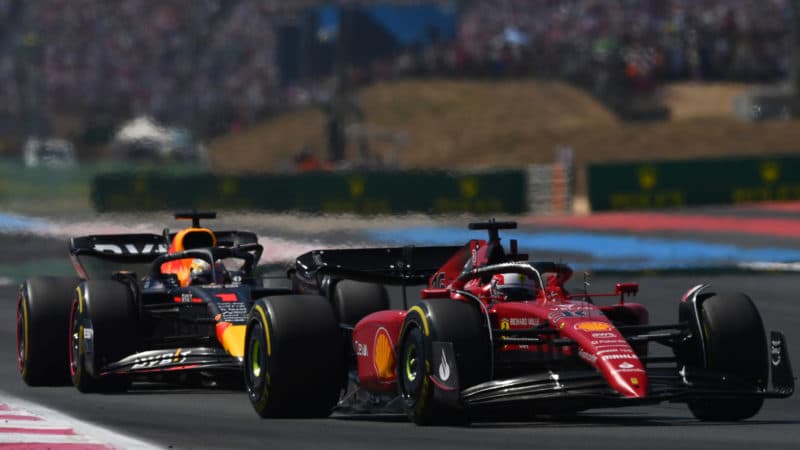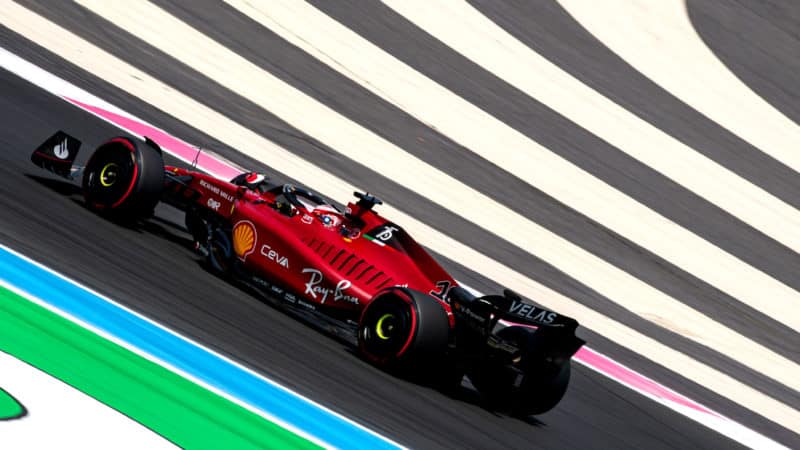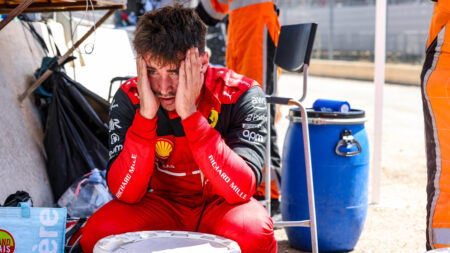But who was to say which the dominant tyre mechanism was going to be? Thermal degradation or simple wear? It was not clear-cut.
But what was very plain was the Ferrari’s stunning speed through the fast corners, Le Beausset (Turn 11) in particular. That was more than enough to overcome the Red Bull’s greater straightline speed. Add to that Sainz being available to give Leclerc a valuable tow in Q3 (on account of him starting from the back regardless), and Leclerc was over 0.3sec faster than Verstappen in qualifying.
But over a race stint? Who had got it right?
As it turned out, the two contrasting mechanisms of tyre behaviour were quite finely-balanced. There was a bit of graining and wear of the front tyres and the thermal degradation was not as bad as feared. So in the first stint, as Leclerc led away, Verstappen was pushing him hard, hoping he could make the Ferrari overwork its tyres. Leclerc meanwhile was going as fast as he dared, trying to force Verstappen into using up his tyres.

Following Leclerc closely took its toll on Verstappen’s tyres
Dan Mullan/Getty Images
It was Verstappen’s fronts which eventually gave up first, which was quite natural given how many laps he’d spent in the dirty air of the Ferrari. The Red Bull’s greater straightline speed wasn’t enough to allow Verstappen to overtake, even with DRS, because the Ferrari was quicker onto the straight. So advantage Ferrari in this first stint.
But it wasn’t necessarily going to stay that way once Verstappen had taken track position off Ferrari by undercutting. Red Bull brought him in as early as possible, on lap 16, but still intending to one-stop. If the mediums could last 16 laps stuck tight beneath the Ferrari’s rear wing, then the hards could surely do the remaining 37 laps in clear air. Two-stopping was to be avoided at almost any cost because the increased length of the pit lane speed limit area had added an extra 4sec to the stop loss time.
Why didn’t Ferrari respond to Verstappen’s stop?
Because Verstappen’s new-tyred out-lap would have been comfortably faster than Leclerc’s old-tyred in-lap, so high was the degradation rate. So Leclerc had effectively already lost track position.
What Ferrari intended to do instead was run Leclerc for as long as his tyres continued to hold on, with a target stop of lap 22. With tyres six laps newer, Leclerc would likely have been faster and hunting Verstappen down. But he would then have needed to find a way to overtake.
But we never got to see that one play out.
Leclerc’s crash

Leclerc crashes out
Marc de Mattia / DPPI
On front tyres which were just beginning to grain, on lap 18 Leclerc went into Turn 11 late and fast, just as he’d been doing all weekend. But on this occasion the left-rear strayed onto the dust and the white line, at very high speed. Once the rear let go, there was no bringing it back, not even for Leclerc.
He made no excuses afterwards, blamed himself for what was a plain driver error. As he tried to reverse the car out of the barrier, he found the throttle not to be responding. He tried shutting the car off and restarting it, but still the throttle would not respond. He was out and the safety car the incident created brought everyone into the pits for fresh rubber at a 10sec saving over a stop at full racing speed.
Sainz’s bonus
Starting from the back because of engine penalties, Sainz was one of just three cars initially fitted with the hard compound tyres rather than the mediums. He made steady initial progress and by the time of the safety car was mid-pack among the McLarens and Alpines.
A delay at the stop led to him bring released into the path of Alex Albon, which got him a 5sec penalty. But the safety car had wiped the 20sec deficit he’d previously had to the Mercedes pair and Perez and now he was on new mediums with everyone around him having been obliged to switch to hards. This was great for his initial speed and it allowed him to pick off Lando Norris and Fernando Alonso and to quickly close down on Russell and Perez ahead. But it was potentially bad news for his strategy as 37 laps was a bit of a stretch for a set of mediums. He could have converted to a two-stop, but that idea got lost in the chase and passing of Russell (around the outside of Signes) and Perez. He completed the latter move to go third on lap 41 just as the team was telling him to pit!

Sainz passed Perez but lost the position immediately by pitting
Paulo Maria / DPPI
Ferrari reasoned that he didn’t have enough tyre life left to pull out the required 5sec margin over Perez and Russell. So he’d be an official P5 with the penalty applied. Instead, they brought him in for another set of mediums, he took the penalty in the pitlane and was able to finish P5 but with the bonus of a point for fastest lap.
A late VSC for Zhou Guanyu‘s broken-down Alfa gave Russell the opportunity to pounce upon Perez for third, having earlier failed to take the place with a committed move down the inside into the chicane.
Verstappen and Red Bull are winning races even when they are not the fastest. Usually that’s been because the team’s operations and the car’s reliability are better than Ferrari’s. This time it was because its driver showed better judgement.



